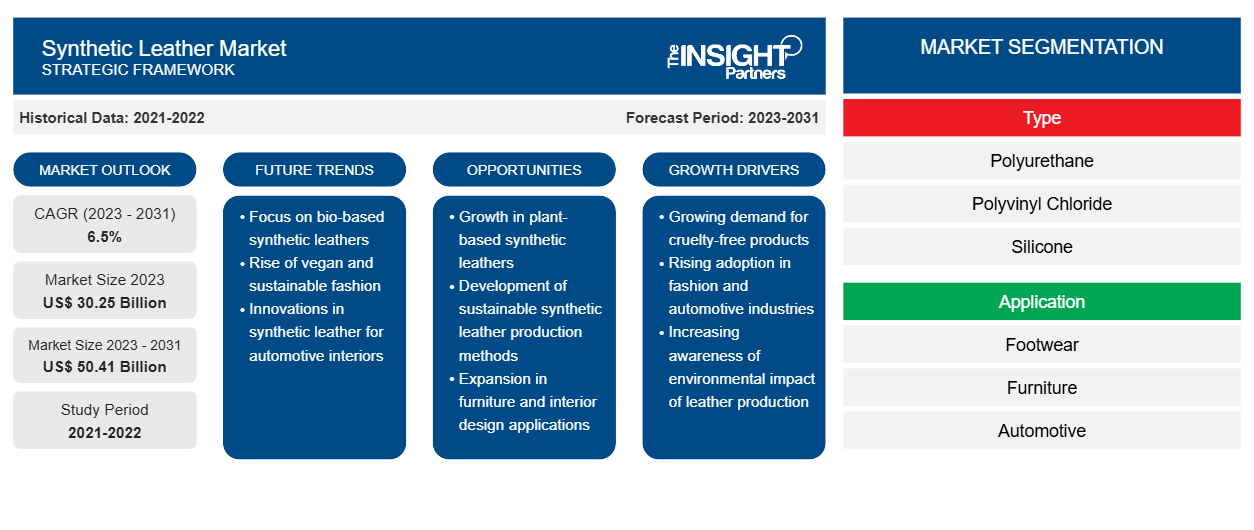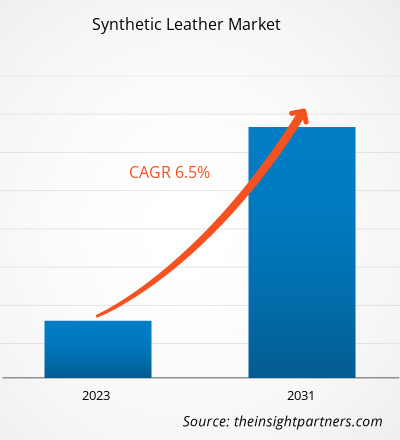Synthetic Leather Market Analysis, Size, and Share by 2031
Historic Data: 2021-2023 | Base Year: 2024 | Forecast Period: 2025-2031Synthetic Leather Market Size and Forecast (2021 - 2031), Global and Regional Share, Trend, and Growth Opportunity Analysis Report Coverage: By Type (Polyurethane, Polyvinyl Chloride, Silicone, and Others); Application (Footwear, Furniture, Automotive, Clothing, Stationery Goods, and Others), and Geography
- Report Date : Mar 2026
- Report Code : TIPRE00003932
- Category : Chemicals and Materials
- Status : Data Released
- Available Report Formats :


- No. of Pages : 150
The synthetic leather market is expected to reach US$ 54.16 billion by 2031 from US$ 32.24 billion in 2024; it is anticipated to record a CAGR of 6.5% during the forecast period. The growing focus on the development of biobased leather is likely to remain a key Synthetic Leather Market trend.
Synthetic Leather Market Analysis
Synthetic leather has gained popularity is the last few years. It is used in various industries, including footwear, clothing, furniture, and automotive. The most common use of synthetic leather is in clothing, luggage, and cases. synthetic leather is increasingly used in jackets, coats, handbags, purses, belts, etc. Synthetic leather is suitable for footwear application due to its low cost, and abrasion resistance.
Synthetic Leather Market Overview
Synthetic leather is prepared by extrusion of raw materials such as polyvinyl chloride, polyurethane, color pigments, backing materials, and others. The growing demand from industries such as furniture, footwear, and automotive is expected to drive the demand for synthetic leather. In addition, growing investments by major players are expected to boost the market growth.
Customize This Report To Suit Your Requirement
You will get customization on any report - free of charge - including parts of this report, or country-level analysis, Excel Data pack, as well as avail great offers and discounts for start-ups & universities
Synthetic Leather Market: Strategic Insights

-
Get Top Key Market Trends of this report.This FREE sample will include data analysis, ranging from market trends to estimates and forecasts.
Synthetic Leather Market Drivers and Opportunities
Advantages of Synthetic Leather
Synthetic leather provides several advantages. It reflects a visual appearance with realistic leather quality when modified and improved. It is a versatile material available in a variety of colors, finishes, and patterns. The cost of synthetic leather is lesser as compared to genuine leather, which makes it a much more affordable option. Moreover, synthetic leather is a waterproof material and can resist water penetration since it consists of a plastic base layer with a plastic coating. As a result, synthetic leather is the perfect choice for applications with continuous exposure to moisture and humidity. Thus, the advantages associated with the usage of synthetic leather are driving the market.
Growing Demand from the Footwear Industry
The footwear industry is one of the significant segments of the synthetic leather industry. The high demand for shoes is providing opportunities for the footwear industry to develop and grow. Synthetic leather material is suitable for shoes due to its low cost and abrasion resistance. Also, synthetic leather shoes offer great waterproof qualities. Synthetic leather can be mixed with a few chemicals to add waterproof features. There is a high demand for synthetic leather from the footwear industry. Moreover, many footwear brands are focusing on developing plant-based leather shoes and vegan leather shoes. This is further contributing to the high demand for synthetic leather. Thus, growing demand from the footwear industry creates opportunities in the synthetic leather market.
Synthetic Leather Market Report Segmentation Analysis
Key segments that contributed to the derivation of the Synthetic Leather Market analysis are base oil, product type, and end-use industry.
- Based on type, the Synthetic Leather Market is divided into polyurethane, polyvinyl chloride, silicone, and others. The polyurethane segment held a larger market share in 2023.
- By application, the market is segregated into footwear, furniture, automotive, clothing, stationery goods, and others. The footwear segment held the largest share of the market in 2023.
Synthetic Leather Market Share Analysis by Geography
The geographic scope of the Synthetic Leather Market report is mainly divided into five regions: North America, Europe, Asia Pacific, Europe, Middle East & Africa, and South America/South & Central America.
Asia Pacific has dominated the Synthetic Leather Market. The Asia Pacific footwear market is driven by rapid urbanization, growing population, and industrialization in countries such as China, Indonesia, and India. Also, the penetration of e-commerce platforms such as Amazon and Alibaba has facilitated consumers' convenient purchase of footwear. As a result, the growing demand from the footwear industry, fashion, and upholstery industries includes a wide variety of items such as shoes and jackets, luggage and wallets, and car interiors—particularly seats, electronics cases, and sofas. Asia Pacific is anticipated to be the fastest growing region in the coming period.
Synthetic Leather Market Regional Insights
The regional trends and factors influencing the Synthetic Leather Market throughout the forecast period have been thoroughly explained by the analysts at The Insight Partners. This section also discusses Synthetic Leather Market segments and geography across North America, Europe, Asia Pacific, Middle East and Africa, and South and Central America.
Synthetic Leather Market Report Scope
| Report Attribute | Details |
|---|---|
| Market size in 2024 | US$ 32.24 Billion |
| Market Size by 2031 | US$ 54.16 Billion |
| Global CAGR (2025 - 2031) | 6.5% |
| Historical Data | 2021-2023 |
| Forecast period | 2025-2031 |
| Segments Covered |
By Type
|
| Regions and Countries Covered |
North America
|
| Market leaders and key company profiles |
|
Synthetic Leather Market Players Density: Understanding Its Impact on Business Dynamics
The Synthetic Leather Market is growing rapidly, driven by increasing end-user demand due to factors such as evolving consumer preferences, technological advancements, and greater awareness of the product's benefits. As demand rises, businesses are expanding their offerings, innovating to meet consumer needs, and capitalizing on emerging trends, which further fuels market growth.

- Get the Synthetic Leather Market top key players overview
Synthetic Leather Market News and Recent Developments
The Synthetic Leather Market is evaluated by gathering qualitative and quantitative data post primary and secondary research, which includes important corporate publications, association data, and databases. The following is a list of developments in the market:
- General Silicones (GS), an expert manufacturer of silicone products with 50 years of experience, is announcing the availability of its new Compo-SiL® SL silicone vegan leather product series. The SL series is suitable for manufacturers of consumer products such as bags and backpacks, shoes, wallets, belts, book bindings, and covers that are looking for vegan leather supplies with factory-applied fabric lining. (Source: General Silicones Co., Ltd., Company News, 2023)
Synthetic Leather Market Report Coverage and Deliverables
The “Synthetic Leather Market Size and Forecast (2021–2031)” report provides a detailed analysis of the market covering below areas:
- Market size and forecast at global, regional, and country levels for all the key market segments covered under the scope
- Market dynamics such as drivers, restraints, and key opportunities
- Key future trends
- Detailed Porter’s Five Forces and SWOT analysis
- Global and regional market analysis covering key market trends, major players, regulations, and recent market developments
- Industry landscape and competition analysis covering market concentration, heat map analysis, prominent players, and recent developments
- Detailed company profiles
Habi is a seasoned Market Research Analyst with 8 years of experience specializing in the Chemicals and Materials sector, with additional expertise in the Food & Beverages and Consumer Goods industries. He is a Chemical Engineer from Vishwakarma Institute of Technology (VIT) and has developed deep domain knowledge across industrial and specialty chemicals, paints and coatings, paper and packaging, lubricants, and consumer products. Habi’s core competencies include market sizing and forecasting, competitive benchmarking, trend analysis, client engagement, report writing, and team coordination—making him adept at delivering actionable insights and supporting strategic decision-making.
- Historical Analysis (2 Years), Base Year, Forecast (7 Years) with CAGR
- PEST and SWOT Analysis
- Market Size Value / Volume - Global, Regional, Country
- Industry and Competitive Landscape
- Excel Dataset
Testimonials
The Insight Partners' SCADA System Market report is comprehensive, with valuable insights on current trends and future forecasts. The team was highly professional, responsive, and supportive throughout. We are very satisfied and highly recommend their services.
RAN KEDEM Partner, Reali Technologies LTDsI requested a report on a very specific software market and the team produced the report in a few days. The information was very relevant and well presented. I then requested some changes and additions to the report. The team was again very responsive and I got the final report in less than a week.
JEAN-HERVE JENN Chairman, Future AnalyticaWe worked with The Insight Partners for an important market study and forecast. They gave us clear insights into opportunities and risks, which helped shape our plans. Their research was easy to use and based on solid data. It helped us make smart, confident decisions. We highly recommend them.
PIYUSH NAGPAL Sr. Vice President, High Beam GlobalThe Insight Partners delivered insightful, well-structured market research with strong domain expertise. Their team was professional and responsive throughout. The user-friendly website made accessing industry reports seamless. We highly recommend them for reliable, high-quality research services
YUKIHIKO ADACHI CEO, Deep Blue, LLC.This is the first time I have purchased a market report from The Insight Partners.While I was unsure at first, I visited their web site and felt more comfortable to take the risk and purchase a market report.I am completely satisfied with the quality of the report and customer service. I had several questions and comments with the initial report, but after a couple of dialogs over email with their analyst I believe I have a report that I can use as input to our strategic planning process.Thank you so much for taking the extra time and making this a positive experience.I will definitely recommend your service to others and you will be my first call when we need further market data.
JOHN SUZUKI President and Chief Executive Officer, Board Director, BK TechnologiesI wish to appreciate your support and the professionalism you displayed in the course of attending to my request for information regarding to infectious disease IVD market in Nigeria. I appreciate your patience, your guidance, and the fact that you were willing to offer a discount, which eventually made it possible for us to close a deal. I look forward to engaging The Insight Partners in the future, all thanks to the impression you have created in me as a result of this first encounter.
DR CHIJIOKE ONYIA MANAGING DIRECTOR, PineCrest Healthcare Ltd.Reason to Buy
- Informed Decision-Making
- Understanding Market Dynamics
- Competitive Analysis
- Identifying Emerging Markets
- Customer Insights
- Market Forecasts
- Risk Mitigation
- Boosting Operational Efficiency
- Strategic Planning
- Investment Justification
- Tracking Industry Innovations
- Aligning with Regulatory Trends




















 Get Free Sample For
Get Free Sample For